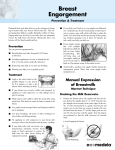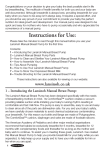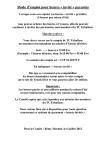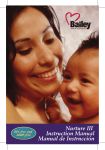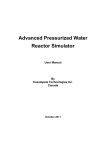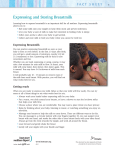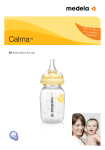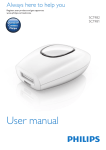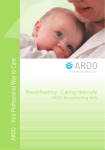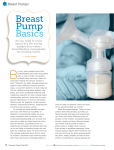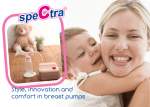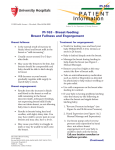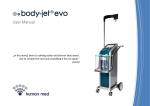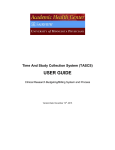Download Breast milk removal and storage
Transcript
For Your Well-Being Breast Milk Removal and Storage Selecting the method of breast milk removal If you’ll be away from your baby during a feeding, you may need another way to empty your breasts. You can do this by hand (hand expression) or use a breast pump. Talk with your breastfeeding resource person to help you decide what will work best for you. Here are some points to consider when choosing a method: • Purpose/frequency: Will you do this daily (e.g., if you are returning to work) or occasionally (e.g., when you go out for the evening)? • Affordability: How much are you willing or able to spend? Will you use the pump again for future children? • Hand expression: Free • Breast pumps range in price and may include: – Manually operated pumps – Electric pumps – Hospital-grade pumps, – Battery-operated pumps usually available as a rental • Availability of pump and replacement parts in your area • Ease of pumping: How much time will you have to pump your breasts? Some pumps will allow for double pumping, decreasing the time spent and increasing the amount of milk. • Ease of use: Is it easy to assemble and clean? Is it dishwasher safe and/or can it be sterilized if necessary? • Do you need an electrical outlet? Is one available where you plan to pump? • The most efficient way to remove breast milk is suckling by a healthy baby. Pumping is not a good way to determine the volume of milk your baby is taking. (See “Baby is Getting Enough Breast Milk When ...”) Which breast pump is best for you? The following chart is provided as a guideline for selecting a breast pump. However, it is strongly recommended that you meet with a lactation consultant such as an IBCLC (International Board Certified Lactation Consultant). Which breast pump is best for you? Do you need a pump for: Manual Small battery or electric Working grade Hospital grade Occasional use A missed feeding An evening out from baby Working part time Best Best Good Better Better Best Daily use Best Working full time Premature or hospitalized baby Best Best Medical reasons Low milk supply Sore nipples or engorgement Good Latch-on problems or breast infection Good Drawing out flat or inverted nipples Better Best Good Best Best Best Best Best Continued X13548 (Rev. 04/13) ©AHC Breast Milk Removal and Storage, Page 2 Milk letdown Suggestions of times to express milk Pumping and hand expression take practice and become easier with time. Here are some hints on how to help your milk begin to flow when baby is not at the breast. • If you are away from the baby, try to express milk when the baby would eat and as often as the baby eats. • Expressing for storing extra milk can be done when you are fuller or if baby did not empty both sides in a feeding. • Express milk one to two hours after baby has fed. • Express milk on one breast while baby is nursing on the other breast. Pumping may be easier because the milk is already flowing. • Have a picture of the baby to look at and/or a piece of the baby’s clothing to stimulate your senses. • Arrange a comfortable place to sit: rocking chair, easy chair, someplace with privacy. • Relax. See your relaxation handouts. • Talk positively about the baby with someone. • Skin to skin contact helps the milk let down. (See “Gentle Massage” section.) • Set a specific routine for removing milk. Preparing to pump with a breast pump • Read the instruction sheet in the kit before using the pump for the first time. Caution: All pumps must suck and release (like a baby feeds) when pumping. • Wash the parts of the breast pump that touch the breast or the expressed milk with clean hot soapy water. Rinse well and air dry. • Wash hands before handling any of the breast pump parts, the breasts, or expressed breast milk. • Center the breast shield over the nipple so the nipple can move in and out without rubbing against the sides. Some pumps have adapters to fit different size nipples. • Turn on pump after positioning the breast shield. Always start pumping on minimum with pumps that have suction regulators. Increase suction to your comfort level; it should not be painful. • If single pumping, switch pump from side to side when the milk flow decreases (or about every 5 minutes) until you have pumped both breasts two to three times. Alternating sides is more stimulating and can result in a higher volume of milk. • Drink enough fluid and get enough rest. Drink to thirst or get into the habit of having something to drink each time you sit down to pump. • Your baby is better than a pump at removing milk from the breast. The amount you pump is not a true way to tell how much milk your baby gets when breastfeeding, especially when you are first learning. Gentle massage Massage the milk producing cells and ducts by pressing the breast firmly with the flat of the fingers into the chest wall, beginning at the top. Move fingers in a circular motion, concentrating on one spot at a time for a few seconds before moving on to another spot. Spiral around the breast toward the areola as you massage. The motion is similar to that used in a breast examination. Continued X13548 (Rev. 04/13) ©AHC Breast Milk Removal and Storage, Page 3 Hand expression of breast milk (Marmet technique) (Information and diagrams used with permission from Medela, Inc.) Draining the milk 1. Position the thumb (above the nipple) and first two fingers (below the nipple) about 1 to 11/2 inches from the nipple, though not necessarily at the outer edges of the areola. Use this measurement as a guide, since breasts and areolas vary in size from one woman to another. Be sure the hand forms the letter “C” and the finger pads are at 6 and 12 o’clock in line with the nipple. Avoid cupping the breast. Incorrect Positioning Correct Positioning 2. Push straight into the chest wall. Avoid spreading the fingers apart. For large breasts, first lift and then push into the chest wall. 3. Roll thumb and fingers forward at the same time. This rolling motion compresses and empties milk without injuring sensitive breast tissue. Note the position of thumb and fingernails during the finish roll as shown in the illustration. 4. Repeat rhythmically. Position, push, roll ... Position, push, roll ... Push into chest wall Roll Right hand Finish roll Left hand 5. Rotate the thumb and fingers to milk other areas, using both hands on each breast. Avoid these motions: • Do not squeeze the breast, as this can cause bruising. • Sliding hands over the breast may cause painful skin burns. • Avoid pulling the nipple, which may result in tissue damage. Squeeze Slide Pulling Continued X13548 (Rev. 04/13) ©AHC Breast Milk Removal and Storage, Page 4 Storage of breast milk • Store breast milk in clean, closed or covered, plastic or glass containers. If using plastic bottle liners, you may want to use two liners to prevent the chance of them breaking. Plastic should be food grade. Bisphenol A (BPA or BisA) may pose a health risk and should be avoided. • Leave about an inch of room at the top of the container, as milk expands when frozen. • If your baby is in the Intensive Care Unit, sterile, heavy plastic containers should be used. • Freeze in small quantities - about 2 ounces. This makes it easier to thaw the breast milk and there is less waste if your baby does not drink much at a feeding. • Cool freshly obtained milk before adding to already frozen milk. This can be done if obtaining small amounts at a time to reach two ounces. • Use a non-toxic marker to label container with date and time pumped. (Oldest milk should be used first.) Label with baby’s name if taking milk to the day care center, sitter or hospital. Breast milk storage Infant at home Freshly expressed breast milk Thawed breast milk (previously frozen) Room temperature 77˚ F (25˚ C) Refrigerator 40˚ F (4˚ C) Home freezer (2-door refrigerator) Freezer -4˚ F (-20˚ C) Up to 6 hours* 8 days* 6 months 12 months Up to 4 hours 24 hours Never refreeze thawed breast milk Never refreeze thawed breast milk * Researchers state that freshly expressed breast milk can be left at room temperature for up to 6 hours. However, it is preferable to refrigerate breast milk as soon as possible after pumping. Thawing breast milk • Place milk in refrigerator the night before you are going to use it. Refrigerator thawing takes about 12 hours. • Place frozen milk in a pan of warm water or under warm running water to thaw. • Do not use hot water or boiling water as this can destroy some of the milk’s ability to fight infection. • Never microwave as this will cause hot spots that can burn your baby. It can also change the composition of the milk. • Do not refreeze thawed breast milk. • Fat in breast milk will separate and rise to the top. By gently swirling the container, you can mix any fat that may have separated. • The color, consistency and odor of your breast milk may vary depending upon your diet. • Discard any milk left in the bottle after 1 hour. Intake guidelines If your baby isn’t eating any solids (if he’s younger than 4 to 6 months, he shouldn’t be), a general guideline to determine your baby’s daily milk or breast milk intake range is to multiply your baby’s weight by two. This is the lower end of how many ounces he needs in a 24 hour period. Then multiply his weight by 2.5. This is the upper range of ounces required. Breastfed babies usually eat in frequent small amounts. The amount you feed your baby depends on your baby’s size, age and appetite. Call your baby’s health care provider if you are concerned about your baby’s eating, weight gain or health. The information presented is intended for general information and educational purposes. It is not intended to replace the advice of your health care provider. Contact your health care provider if you believe you have a health problem. AuroraHealthCare.org X13548 (Rev. 04/13) ©AHC




